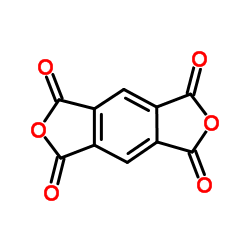X-ray diffraction study of the disorder-to-order transition at approximately 160 K in the pi-molecular compound pyrene ... pyromellitic dianhydride.
F H Herbstein, S Samson
文献索引:Acta Crystallogr. B 50 ( Pt 2) , 182-91, (1994)
全文:HTML全文
摘要
The crystal structure of pyrene ... pyromellitic dianhydride [(C16H10:C10H2O6); PYRPMA] has been studied over the range 300-19 K, using the low-temperature accessory designed by Samson, Goldish & Dick [J. Appl. Cryst. (1980), 13, 425-432] for a four-circle diffractometer. Earlier results for the disordered and ordered structures [Herbstein & Snyman (1969). Philos. Trans. R. Soc. London Ser. A, 264, 635-666] are confirmed and extended. At 295 K, a = 13.94 (1), b = 9.34 (1), c = 7.31 (1) A, beta = 93.65 (9) degrees, space group P2(1)/a, Z = 2, with pyrenes and pyromellitic dianhydrides (PMDAs) at crystallographic centres of symmetry. At 19 K, a = 13.664 (3), b = 9.281 (2), c = 14.420 (3) A, beta = 91.80 (2) degrees, space group P2(1)/n, Z = 4, with two sets of pyrenes at independent centres of symmetry and the four PMDAs at general positions. There are no discontinuities in cell dimensions with temperature (measurements at approximately 10 K intervals, down to 19 K) but db/dT and d beta/dT show discontinuities at approximately 167 K. Superlattice reflections appear below approximately 164 K (= Tc by X-ray diffraction), corresponding to the doubling of c and change of space group; the specific heat shows an anomalous increase over the range 120-155 K, giving a lambda-type peak. These results show that the transition is second order with regard to Ehrenfest's criteria. PYRPMA is a co-elastic crystal and quantitative analysis shows a linear dependence of the squares of spontaneous strain and of normalized superlattice intensity on temperature; hence, in terms of Landau theory, the transition is tricritical. However, the excess specific heat cannot be explained entirely on this basis. The physical nature of the transition is discussed. PYRPMA is so far unique among the pi-molecular compounds showing disorder-to-order transitions in the solid state in that there is a doubling of one of the axes; all indications are, however, that it resembles the other examples in the sense that subtle intermolecular packing interactions (here between pyrenes and PMDAs) are the driving force for the transition rather than electronic or charge-transfer interactions.
相关化合物
| 结构式 | 名称/CAS号 | 分子式 | 全部文献 |
|---|---|---|---|
 |
均苯四甲酸酐
CAS:89-32-7 |
C10H2O6 |
|
Covalent molecular assembly of oligoimide ultrathin films in...
2005-08-16 [Langmuir 21(17) , 7812-22, (2005)] |
|
Novel zwitterionic inorganic-organic hybrids: synthesis of h...
2011-02-28 [J. Hazard. Mater. 186(2-3) , 1335-42, (2011)] |
|
NTCDA-TTF first axial fusion: emergent panchromatic, NIR opt...
2012-07-04 [Chem. Commun. (Camb.) 48(52) , 6475-7, (2012)] |
|
[The lipid peroxidation system in the organism of experiment...
2003-01-01 [Patol. Fiziol. Eksp. Ter. (1) , 26-8, (2003)] |
|
"Thermal Stabilization Effect" of Al2O3 nano-dopants improve...
2015-01-01 [Sci. Rep. 5 , 16986, (2015)] |